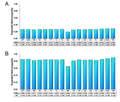File:Neighbor-Joining tree of Mlabri and others based on allele sharing distance.png
From Wikimedia Commons, the free media repository
Jump to navigation
Jump to search

Size of this preview: 543 × 600 pixels. Other resolutions: 217 × 240 pixels | 435 × 480 pixels | 695 × 768 pixels | 1,200 × 1,325 pixels.
Original file (1,200 × 1,325 pixels, file size: 232 KB, MIME type: image/png)
File information
Structured data
Captions
Captions
Add a one-line explanation of what this file represents
| DescriptionNeighbor-Joining tree of Mlabri and others based on allele sharing distance.png |
English: Relationships among 446 individuals reconstructed using Neighbor-Joining method on a matrix of allele sharing distances (ASDs). Pairwise ASD was calculated using 55,561 autosomal SNPs. Individuals are shaded by different colors according to their ethnic or linguistic affiliations.
|
| Date | Published: 19 March 2010 |
| Source | Xu S, Kangwanpong D, Seielstad M, et al. Genetic evidence supports linguistic affinity of Mlabri - a hunter-gatherer group in Thailand. BMC Genetics. 2010;11:18. doi:10.1186/1471-2156-11-18. https://bmcgenet.biomedcentral.com/articles/10.1186/1471-2156-11-18 |
| Author | Shuhua Xu, Daoroong Kangwanpong, Mark Seielstad, Metawee Srikummool, Jatupol Kampuansai, Li JinEmail author and The HUGO Pan-Asian SNP Consortium |
| Other versions |
|
This file is licensed under the Creative Commons Attribution 2.0 Generic license.
|
This file was published in a BioMed Central journal. Their website states that all of its research publications is published under the license which is identical to the Creative Commons Attribution 2.0 license (some non-research articles like reviews or editorials may require a subscription.)
To the uploader: You must provide a link (URL) to the original file or journal article. English | 日本語 | македонски | +/− |
File history
Click on a date/time to view the file as it appeared at that time.
| Date/Time | Thumbnail | Dimensions | User | Comment | |
|---|---|---|---|---|---|
| current | 10:57, 25 January 2017 |  | 1,200 × 1,325 (232 KB) | Was a bee (talk | contribs) | {{Information |Description={{en|1=Relationships among 446 individuals reconstructed using Neighbor-Joining method on a matrix of allele sharing distances (ASDs). Pairwise ASD was calculated using 55,561 autosomal SNPs. Individuals are shaded by differe... |
You cannot overwrite this file.
File usage on Commons
The following 6 pages use this file:
- File:Expected heterozygosity of Mlabri.png
- File:Geographical distribution of Thailand population samples.png
- File:Maximum likelihood tree of 17 populations including Mlabri.png
- File:Neighbor-Joining tree of Mlabri and others based on allele sharing distance.png
- File:PCA plot for 446 individuals representing 15 populations including Mlabri.png
- File:Population structure of Mlabri and others (inferred by STRUCTURE and frappe).png





